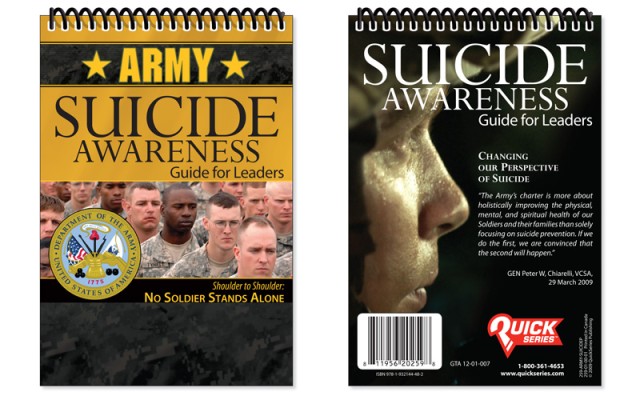WASHINGTON (Army News Service, Nov. 4, 2009) -- The Army's newest guide book is small enough to fit in a pocket, but big enough to save lives, according to officials.
The Army has released a pocket-sized suicide awareness guide for small-unit leaders to use as a comprehensive, quick reference for identifying Soldiers at risk and connecting them to suicide-intervention resources.
"The guide has much of the information Army leaders needs to recognize that one of their Soldiers is hurting and then guides them to a resource that may save that Soldiers life," said Brig. Gen. Colleen McGuire, director, Army Suicide Prevention Task Force.
"One of the challenges we confront is simplifying the suicide prevention effort," McGuire said. "There are so many good tools out there; Army leaders sometimes don't know where to turn first. The guide is one of the ways we're making it easier to understand what to do and where to go if you're confronted with a Soldier who may be thinking of harming themselves."
The pocket-sized guidebook highlights the Army-approved 'Ask, Care and Escort' or 'ACE' model for suicide intervention. It also contains information on de-stigmatizing the pursuit of behavioral health services.
The guide covers the steps leaders can take to mitigate suicide within their units, provides mechanisms for enhancing Soldier and family resiliency, along with listing references to command, chaplain, installation military and family-life consultant-support services available throughout the Army community.
"We needed to place a lot of information in an easily accessible and understandable format and the pocket suicide awareness guide helps us do that," said Walter Morales, Army suicide prevention program manager.
"If you're a commander or NCO and want to learn fast about the Army's suicide prevention effort, the guide is the place to start," Morales said.
The pocket-sized guide is now available for distribution from Training and Audiovisual Support Centers Army-wide. In the future, units can order additional copies through their TASC to sustain their suicide-prevention effort.
"I hope to see copies of the guide all over the Army in the coming months," added McGuire. "Effective suicide prevention requires informed small-unit leadership. So we have to give our small unit leaders the knowledge to handle this unique responsibility."
For more information about Army suicide prevention programs, visit http://www.armyg1.army.mil/hr/suicide/default.asp




Social Sharing